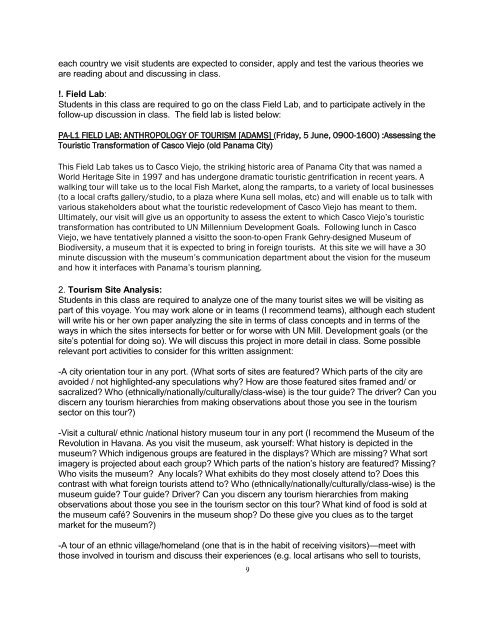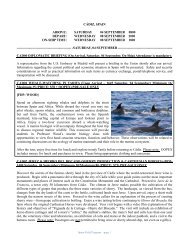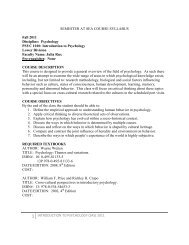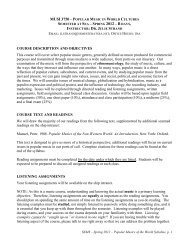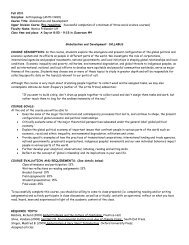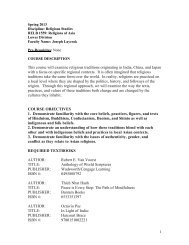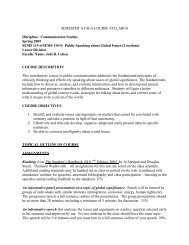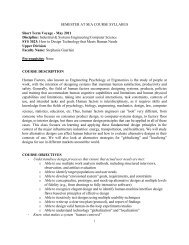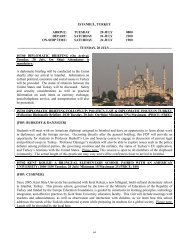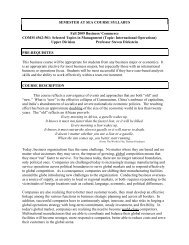ANTH 3559 - University of Virginia
ANTH 3559 - University of Virginia
ANTH 3559 - University of Virginia
You also want an ePaper? Increase the reach of your titles
YUMPU automatically turns print PDFs into web optimized ePapers that Google loves.
each country we visit students are expected to consider, apply and test the various theories we<br />
are reading about and discussing in class.<br />
!. Field Lab:<br />
Students in this class are required to go on the class Field Lab, and to participate actively in the<br />
follow-up discussion in class. The field lab is listed below:<br />
PA-L1 FIELD LAB: <strong>ANTH</strong>ROPOLOGY OF TOURISM [ADAMS] (Friday, 5 June, 0900-1600) :Assessing the<br />
Touristic Transformation <strong>of</strong> Casco Viejo (old Panama City)<br />
This Field Lab takes us to Casco Viejo, the striking historic area <strong>of</strong> Panama City that was named a<br />
World Heritage Site in 1997 and has undergone dramatic touristic gentrification in recent years. A<br />
walking tour will take us to the local Fish Market, along the ramparts, to a variety <strong>of</strong> local businesses<br />
(to a local crafts gallery/studio, to a plaza where Kuna sell molas, etc) and will enable us to talk with<br />
various stakeholders about what the touristic redevelopment <strong>of</strong> Casco Viejo has meant to them.<br />
Ultimately, our visit will give us an opportunity to assess the extent to which Casco Viejo’s touristic<br />
transformation has contributed to UN Millennium Development Goals. Following lunch in Casco<br />
Viejo, we have tentatively planned a visitto the soon-to-open Frank Gehry-designed Museum <strong>of</strong><br />
Biodiversity, a museum that it is expected to bring in foreign tourists. At this site we will have a 30<br />
minute discussion with the museum’s communication department about the vision for the museum<br />
and how it interfaces with Panama’s tourism planning.<br />
2. Tourism Site Analysis:<br />
Students in this class are required to analyze one <strong>of</strong> the many tourist sites we will be visiting as<br />
part <strong>of</strong> this voyage. You may work alone or in teams (I recommend teams), although each student<br />
will write his or her own paper analyzing the site in terms <strong>of</strong> class concepts and in terms <strong>of</strong> the<br />
ways in which the sites intersects for better or for worse with UN Mill. Development goals (or the<br />
site’s potential for doing so). We will discuss this project in more detail in class. Some possible<br />
relevant port activities to consider for this written assignment:<br />
-A city orientation tour in any port. (What sorts <strong>of</strong> sites are featured? Which parts <strong>of</strong> the city are<br />
avoided / not highlighted-any speculations why? How are those featured sites framed and/ or<br />
sacralized? Who (ethnically/nationally/culturally/class-wise) is the tour guide? The driver? Can you<br />
discern any tourism hierarchies from making observations about those you see in the tourism<br />
sector on this tour?)<br />
-Visit a cultural/ ethnic /national history museum tour in any port (I recommend the Museum <strong>of</strong> the<br />
Revolution in Havana. As you visit the museum, ask yourself: What history is depicted in the<br />
museum? Which indigenous groups are featured in the displays? Which are missing? What sort<br />
imagery is projected about each group? Which parts <strong>of</strong> the nation’s history are featured? Missing?<br />
Who visits the museum? Any locals? What exhibits do they most closely attend to? Does this<br />
contrast with what foreign tourists attend to? Who (ethnically/nationally/culturally/class-wise) is the<br />
museum guide? Tour guide? Driver? Can you discern any tourism hierarchies from making<br />
observations about those you see in the tourism sector on this tour? What kind <strong>of</strong> food is sold at<br />
the museum café? Souvenirs in the museum shop? Do these give you clues as to the target<br />
market for the museum?)<br />
-A tour <strong>of</strong> an ethnic village/homeland (one that is in the habit <strong>of</strong> receiving visitors)—meet with<br />
those involved in tourism and discuss their experiences (e.g. local artisans who sell to tourists,<br />
9


